Apple's 2010 MacBook Air (11 & 13 inch) Thoroughly Reviewed
by Anand Lal Shimpi on October 26, 2010 10:08 PM EST- Posted in
- Mac
- Apple
- MacBook Air
- Laptops
The 11-inch MacBook Air: Faster than the old 13-inch MacBook Air
On paper, the new 13-inch MacBook Air shouldn’t be any faster than the old 2008 MacBook Air - at least in CPU bound tasks. The 2010 model gets a faster GPU but the CPU is literally the same 1.86GHz Core 2 Duo. Memory sizes and speeds haven’t changed either. While the SSD is faster, if you’re running a CPU bound benchmark there shouldn’t be any performance difference. If you assumed the same thing I did, you’d be very wrong.
Take a look at Cinebench 11 comparing the 2008 13-inch MacBook Air to the two 2010 models:
| Cinebench 11 - Multithreaded CPU Benchmark | |||||
| 11-inch MacBook Air (2010) - 1.4GHz Core 2 Duo | 13-inch MacBook Air (2010) - 1.86GHz Core 2 Duo | 13-inch MacBook Air (2008) - 1.86GHz Core 2 Duo | |||
| Cinebench 11 Score (Higher is Better) | 0.81 | 1.1 | 0.70 | ||
Not only is the 2008 13-inch MBA slower than the new 13-inch model, it’s actually slower than the 11-inch model running at 1.4GHz. Something is amiss. Perhaps it’s just this benchmark?
I turned to our Handbrake H.264 encode test to verify my sanity:
| Handbrake 0.94 - H.264 High Profile Transcode | |||||
| 11-inch MacBook Air (2010) - 1.4GHz Core 2 Duo | 13-inch MacBook Air (2010) - 1.86GHz Core 2 Duo | 13-inch MacBook Air (2008) - 1.86GHz Core 2 Duo | |||
| Average Frames per Second (Higher is Better) | 1.14 fps | 1.55 fps | 0.96 fps | ||
Once again, a similar situation. The old MBA is actually slower than the new 11-inch, despite the advantage in CPU speed.
It looks like what we’ve stumbled upon is a combination of Apple aggressively throttling the clock speed of the older MacBook Air CPUs to meet thermal requirements, and the CPUs used in the new MacBook Airs being far better behaved from a voltage/power consumption standpoint.
The 45nm process these Core 2s are built on is as mature as it’s going to get. I’m guessing yield on these parts is as high as can be and as a result, power consumption is probably consistently lower than the original 1.86GHz parts Apple shipped back in 2008. The peak thermal specs themselves haven’t changed, but the actual power characteristics have.
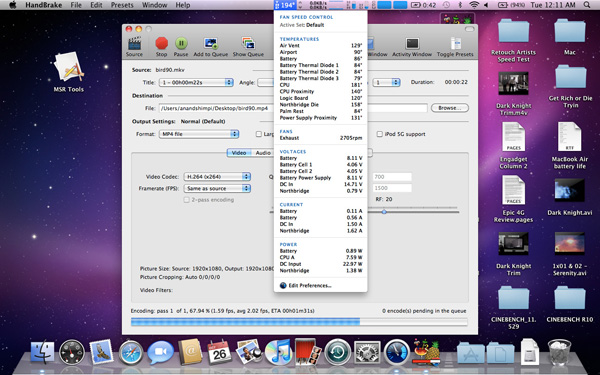
The 2008 MacBook Air under Load
Maximum temperature, at least reported by the MBA’s sensors, isn’t any lower on the new 13-inch than the 2008 I compared it to. Both CPUs hit roughly 84C (183F) under full load. But look at what happens to the chips after a minute at that load:
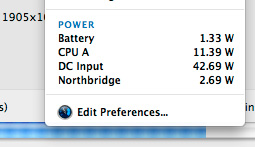 2010 13-inch MacBook Air |
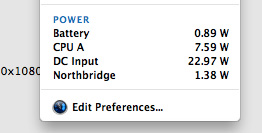 2008 13-inch MacBook Air |
iStat Menus reports the 1.86GHz Core 2 Duo in the 2008 system consuming only 7.59W, while the same CPU in the 2010 machine is drawing 11.45W. The 2008 machine is throttling back to reduce overall temperature while the 2010 system keeps going.
As a result, even the 11-inch MacBook Air will probably end up being as fast, if not faster than the 2nd generation 2008 13-inch MacBook Air. And our performance results confirm that:
| 11-inch MacBook Air (2010) vs. 13-inch MacBook Air (2008) | ||||||||
| Application Launch Test | Adobe Photoshop CS4 | Aperture RAW Import | Cinebench R10 - 1CPU | Cinebench R10 - XCPU | Quicktime H.264 Transcode | |||
| Apple 11-inch MacBook Air (2010) - 1.4GHz Core 2 Duo | 27.8 seconds | 72.4 seconds | 1.29 PPS | 1612 | 2967 | 33.1 fps | ||
| Apple 13-inch MacBook Air (2008) - 1.86GHz Core 2 Duo | 26.4 seconds | 71.3 seconds | 1.20 PPS | 2046 | 2882 | 30.1 fps | ||
You'll notice the less CPU intensive tasks are quicker on the old 13-inch system as the CPU isn't able to get hot enough to trigger Apple's throttling. The single threaded Cinebench test is the best example of this. The 26% performance advantage jibes with the 33% increase in CPU clock speed (it's actually a little low, most likely because the old CPU still isn't running at full speed even in this test). But now look at the heavier tests - the multithreaded Cinebench test and the Quicktime encode. Both of these stress both cores and drive TDP up, which forces Apple to pull clock speed back down. We wondered how Apple was able to cram such a high speed CPU into such a thin chassis as early as it did, now we know.
In practice I found the 2008 13-inch MBA launched applications quicker (short bursts of full clock speed), but after prolonged use or completing CPU intensive tasks it was tough to tell apart from the new 11-inch. What's even more troublesome is that Apple's aggressive clock throttling went relatively undetected until now. This is something I'm going to have to devise tests for and pay more attention to in future reviews. Sneaky, Steve, sneaky.
External Temperatures and Noise
The old MacBook Air chassis had a few dozen slits cut out of the aluminum for ventilation. The new MacBook Air chassis hides the ventilation slits between the base of the unit and the hinge. You can’t see them, but they’re there.
The slits are smaller than they were on the old chassis, which means moving air through them at the same rate sounds louder than before.
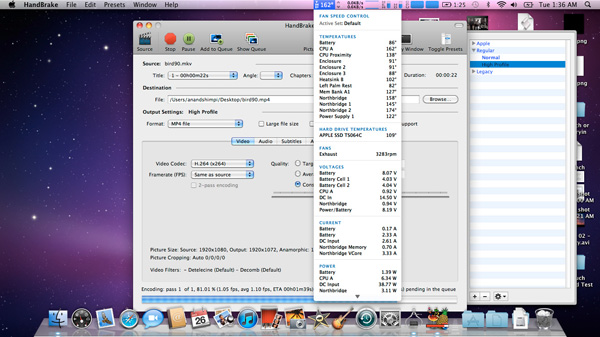
The 11-inch MacBook Air under Load
The CPU in the 11-inch model, even when under heavy loads, likes to stay at or below 72C (162F). At that temperature, the internal fan doesn’t spin above 4000 RPM (usually down below 3400). The 13-inch MacBook Air however is far more likely to generate noise. Running our simple Handbrake test the CPU will peak at over 82C (~180F) and the system’s internal fan will ramp up to over 6K RPM to compensate. Not only does the chassis get hot, but the fan gets audible. It’s still too small of a fan to really be considered loud in the grand scheme of things, but it’s loud enough to be annoying.
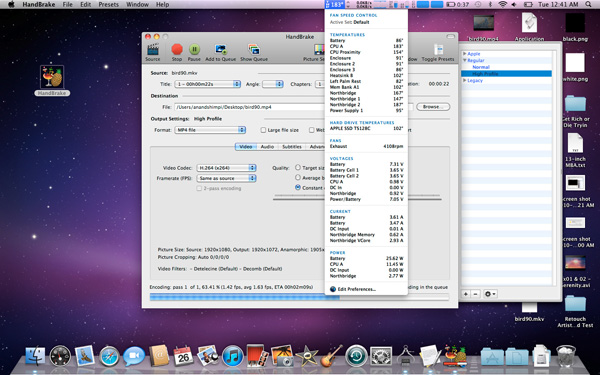
The 13-inch Macbook Air under Load
The surface temperature of the new 13-inch MacBook Air easily gets as high as the 2008 model. I measured a peak of 38.9C (102F) on both the 2008 and 2010 13-inch models. The 11-inch never broke 38C (100F).
Even casual use can ramp up temperatures pretty quickly. Just having a few websites open in the background that use Flash or other CPU intensive elements can slowly cause the MBA’s internal temperatures to rise. And now you’re beginning to see why Apple doesn’t install Flash on these things by default.
The danger zone is the upper left corner of the system, near the hinge. There’s only a single fan that cools both the CPU and GPU in the Air’s very tight enclosure. This is where that fan sits.










185 Comments
View All Comments
deslock - Thursday, October 28, 2010 - link
Thanks Anand & Vivek for the detailed and interesting review. I hope you post a followup with more info on how Apple was able to get this level of performance out of the hardware (vs other similar SSD-equipped machines). Also I'd like to see a long term test of performance (because of the lack of TRIM), or perhaps additional testing showing just how effective the new MBAs are with GC.Oscarcharliezulu - Thursday, October 28, 2010 - link
Thanks for a great, detailed review that doesn't gloss over any point. I've read as many reviews as I can find and many gloss over or just take things as a given - not much more useful than the Apple web site. Your review was detailed in all the right areas. I know where I will be disappointed and where I will be happy. No surprises thanks to your review.I think for a business user (web + mail + Word processing + presentations + lightweight spreadsheet) the Air's may be pretty good - finally great battery life (with wifi active) so I can go out to a customer and work off battery all day without carrying an extra battery or carrying the AC adapter.
Pity about the price - once you tick the options the price becomes ridiculous when you compare to mainstream laptops. I will have to stick to a base model + 4GB ram, and wait to upgrade the SSD later (someone is sure to come up with an upgrade).
And graphics - for ultraportables its good, but the higher end pro's etc really need a lot more grunt - we should be able to play games at High at native resolution.
pmeinl - Friday, October 29, 2010 - link
Just stumbled across an SSD 256GB upgrade kit for the 11.6":http://www.photofast.tw/products/GM2_SFV1_Air.html
It includes an USB adapter for using the orginal SSD as portable storage.
mutatio - Friday, October 29, 2010 - link
Anyone else hear this thing screaming for Fusion in it? If AMD can finally get their power specs in line to be competitive with intel the 11" would be one smoking little monster if Apple bites at it. :-)63jax - Friday, October 29, 2010 - link
don't hurry to change your mac's, just wait for AMD to release their Fuzion chips and then we will have the perfect Mac's. i know i will...Norrah - Saturday, October 30, 2010 - link
I would really like to see how an older Macbook Air (rev c) with an aftermarket SSD would hold up against the new.. performance wise!I need the last kick, if i am to go for the new.
jorjitop - Saturday, October 30, 2010 - link
I think that there is another factor you missed which makes a difference to the relative performances. That is, the 11 inch has a 800 Mhz front bus, while the 13 inch has a 1066 Mhz front bus. In my experience, this makes a noticeable difference to performance.Brooklynzoned - Saturday, October 30, 2010 - link
Both models are 2010, Both machines are running Window's 7. Both Machines Score a 5.3 out of 7Apple Macbook Pro with a 2.4 8G Ram with a Seagate XT Hybrid....Scored 5.3
Apple Macbook Air with a 2.13 4G Ram with the 256 SSD Flash......Scored 5.3
Dell Adamo Onyx With a 1.4 4G Ram with a 128SSD .....................Scored 3.2
Funny thing is the Macbook Pro has a video card with 256 dedicated memory
the macbook air has shared video memory.... and scored higher in the 3D
Brooklynzoned - Saturday, October 30, 2010 - link
Battery Life Amazing,Speed,, Oh Yeah this baby moves.... N quick.. Faster then my Macbook Pro
its crazy how fast it starts up... not from sleep but from a full shutdown and startup. Fast...
The Macbook Air is The future of what a Notebook Should be.
ioannis - Sunday, October 31, 2010 - link
Anand,on page "The 13", the captions at the top seem to suggest that you are comparing the 13" MBA with 15" MBP, while the text suggests otherwise (13" MBA vs 13" MBP, which makes more sense).
thanks